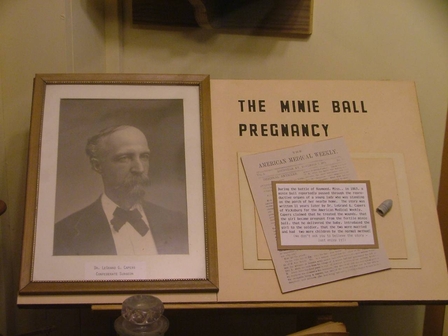Son of a gun : Case of the Miraculous Bullet
Source : http://www.museumofhoaxes.com
In November 1874 an unusual article appeared in the introductory volume of The American Medical Weekly, a Louisville medical journal. It was written by Dr. LeGrand G. Capers and was titled, “Attention Gynaecologists!Notes from the Diary of a Field and Hospital Surgeon, C.S.A.” In the article Dr. Capers recounted an unusual case of artificial insemination he had witnessed on a Civil War battlefield in Mississippi, in which a bullet had passed through a soldier’s testicles, and then traveled on before hitting a woman and impregnating her. The event was said to have occurred on May 12, 1863 at around 3 p.m. at the “battle of R.” (battle of Raymond), where “Gen. G’s brigade” (Brigadier General John Gregg) of the Confederate forces fought Grant’s army led by “Gen. L.” (Major General John A. Logan).

In 1874, The American Medical Weekly ran an article by a Dr. LeGrand Capers (that’s him in the picture) who claimed he witnessed this very thing on a Civil War battlefield. Apparently there was a house very close to the Confederate lines, and a bullet (a “minnie ball”) hit a soldier, “carrying away the left testicle”, and then continued its course toward the house. One of the daughters in the house had also been hit by a stray bullet, which was lost in the abdominal cavity somewhere.
Because the doctor was stationed with the army nearby, he continued to check on the wounded girl over the next several months. Around the six-month mark, he discovered that the girl was pregnant. Around the nine-month mark, she gave birth to a nine-pound baby boy.
The family was beyond embarrassed that their unmarried daughter was apparently having “indiscretions”, but the girl swore that she was a virgin. The doctor examined her and said it was true – she had never had sex. Meanwhile, the little boy was very sick and he had some incredible swelling in the groin area. The doctor decided to operate, and when he did, he pulled out a minnie ball. He put two and two together and figured out that the bullet must have picked up some semen went it ripped through the soldier’s testicle, and managed to impregnate the girl when it lodged inside of her stomach. Supposedly, the girl and the soldier ended up getting married and having two more kids.
The problem? The doctor had invented the whole story in order to mock the ridiculous stories that were coming out of the battlefield. But it was taken as fact, and was even reprinted in 1959 in the New York State Journal of Medicine.
One of the most enduring urban legends of military history sometimes passed off as fact is that of the minie ball pregnancy. The evolution of the firearm brought about the muzzle loading rifled musket by the 19th century. The revolutionary bullet of that weapon was the minie ball invented in the 1840s by the French Army captains Minié and Henri-Gustave Delvigne. This type of bullet was used as early as the Crimean war and was the most popular front line infantry projectile in the Civil War. The basis of the tale is that one of these instruments of war was fired through the groin area of a Confederate soldier and subsequently ricocheted into the ovaries of a nearby southern bell whose home bordered the battlefield in question. Nine months later a baby was born and eventually the soldier, being a gentleman, married the young mother and everyone lived happily ever after.
According to Dr. Capers, who was an army doctor for the confederates, he was with his regiment as the fighting was occurring. A house stood about 300 yards behind the confederate lines, and the residents of the house (a mother, her two daughters, and their servants) were standing in front of it watching the battle and waiting to aid any fallen confederate soldiers. Suddenly Dr. Capers noticed a soldier fall to the ground, and at the same instant he heard a scream from the house. He attended the fallen soldier who had been hit in the leg by a minnie ball. Dr. Capers also noticed that the bullet had “ricochetted from these parts, and, in its onward flight, passed through the scrotum, carrying away the left testicle.”
While dressing the soldier’s wounds, the mother from the house ran up to him and urged him to attend her daughter. The doctor complied and found that the eldest daughter had been also wounded by a minnie ball. In her case, the bullet “had penetrated the left abdominal parietes, about midway between the umbilicus and anterior spinal process of the ilium, and was lost in the abdominal cavity, leaving a ragged wound behind.”
The doctor only had time to prescribe the girl an anodyne before he was forced to retreat from the house with his regiment. However, over the course of the next two months, being stationed with the wounded at the nearby village of Raymond, he was able to visit the young woman regularly and watched her fully recover from her wound. Six months later he happened to be in the neighborhood of Raymond again and visited the girl. He found that her stomach had begun to swell. Three months further on she gave birth to an eight pound son.
The family, being of strict morality, was mortified that their unmarried daughter had given birth. The daughter, however, repeatedly insisted that she was a virgin and didn’t know how such a thing could have happened. Dr. Capers examined her and found that her hymen was intact. Nevertheless he gave no credence, at the time, to her insistence that she was a virgin. But three weeks later the grandmother of the new child asked Dr. Capers to examine the boy because the child’s scrotum was dangerously enlarged and sensitive. The doctor examined the boy, decided to operate and, to his astonishment, found a minnie ball embedded inside the child.
After much reflection, trying to figure out how a bullet could have become lodged inside the child, Dr. Capers figured out the incredible series of events that must have happened. He remembered treating the young man who had suffered from a bullet passing through his left testicle. This same bullet, he determined, must have then continued on its flight, carrying with it particles of semen, before it finally came to rest in the young women’s abdomen, impregnating her, and afterwards working its way into the child’s flesh. He explained the bizarre situation to the family, and they requested to meet the soldier. The soldier and the young woman ended up marrying each other and produced two more children in a more conventional manner.
After appearing in the American Medical Weekly, this Civil War story became something of a legend. Its origins and details became obscured, but the basic outline of the tale was frequently repeated. A medical journal repeated it as true as late as 1959 (F. Donald Napolitani, “Two Unusual Cases of Gunshot Wounds of the Uterus,” New York State Journal of Medicine, 59, 1959, 491-93). But the story is not true. It was entirely invented by Dr. Capers who apparently wanted to poke fun at the numerous highly embellished, often spurious, Civil War stories then being told in the 1870s.
But the joke ended up being on Dr. Capers. The highly respectable doctor had submitted the story to the American Medical Weekly anonymously, not wishing his name to be forever attached to such a ridiculous tale. However, the editor of the journal, E.S. Gaillard, recognizing the doctor’s handwriting and also recognizing that the story was a wild-eyed fiction, turned the tables on the doctor by printing the piece but listing Capers prominently as the author.
Discuss article



